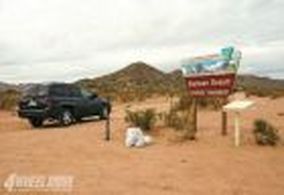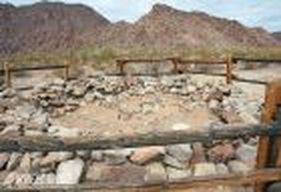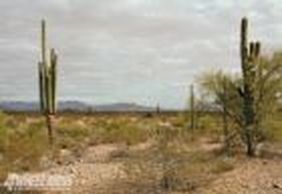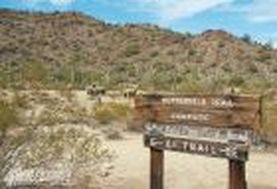Butterfield Stage Route - Bound For Gila Bend
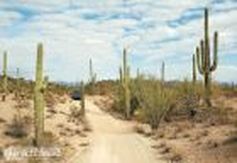
Wagon Wheels Across Arizona
From the August, 2010 issue of 4 Wheel Drive
By Larry E. Heck / Photography by Larry E. Heck
Gold strikes in California during 1848 and 1849 had created the California Gold Rush. The West Coast was booming. Lack of communication between the East and the West was a problem that had to be fixed. With the ocean on one side and the deserts on the other, California was viewed as an island to itself.
The first route for getting mail to and from California was all the way around the tip of South America; Cape Horn. In an effort to shorten the time mail traveled, a new route was formed across the Isthmus of Panama. A one way trip from New York to San Francisco took about 30 days.
Much of the land between St. Louis and San Francisco had just been acquired from Mexico during the American-Mexican war. There were settlements scattered across those territories but they were few and far between. They were isolated from the rest of the country with almost no communications with either the East or the West. Sending mail by ship was not fixing that problem.
A transcontinental mail and passenger route was authorized by an act of Congress in March of 1857. It would be the first mail and passenger government contract to connect the East Coast to the West Coast over land. The new contract, when awarded, would establish a route to connect St. Louis and Memphis to San Francisco. The biggest advantage would be inter-connecting all other communities along the route.
On September 16, 1857, John Butterfield and his associates signed a six-year contract with the Postmaster General. It provided for semi-weekly mail service in both directions between St. Louis/Memphis and San Francisco. According to the contract, the first mail sacks had to leave the three cities within one year, then continue doing so twice each week. Opponents claimed it could not be done.
John Butterfield was president of American Express. He had been in the stagecoach business for many years and was also involved in railroads. One by one, his stage routes were being replaced by trains so he was aware that crossing the western territories was the last frontier for stagecoach use. His business partners were Henry Wells and William Fargo. They owned Wells Fargo, which at that time was primarily involved in the banking business.
Using Wells Fargo financing, John Butterfield, put it all together. He established relay stations an average of 20 miles apart all the way from Tipton, Missouri, to San Francisco. The wagon route was built by utilizing existing roads where possible and building new ones where necessary. Most rivers were forded but ferries were in place for use across the biggest ones.
John Butterfield spent over a million dollars before the first west-bound mail sack was loaded in St. Louis at 8 a.m. on September 16, 1858. Gamblers were placing bets on how long the trip would take long before the first east-bound mail sack was loaded on a stage on September 15 in San Francisco.
The stages ran day and night at an average speed of approximately 5 mph. Seventeen days later, at about noon, the west-bound stage left Maricopa Springs, Arizona, headed for its next stop in Gila Bend.
Approximately 150 years later, at about noon, Lone Writer left Maricopa following the Butterfield Stage route bound for Gila Bend. He followed State Route 238, also known as Maricopa Road, for about 20 miles, then turned right on a sandy access road between mile posts 17 and 18. That access road connects to the original Butterfield Trail after 4.4 miles.
The original Butterfield Trail skirts the southern boundary of the Sonoran Desert National Monument and is maintained by the Boy Scouts of America. Historic signs and trail markers along the way take visitors over Butterfield Pass to the location of a stage stop designated on most maps as Desert Station. It's more modern name is simply Happy Camp.
We found a variety of cactus including an abundance of saguaros. These giants come in many different sizes and shapes. They can live up to 200 years and grow 40 different arms. Being experts at absorbing moisture, they can live up to two years on one good rain storm. When full of water, a single saguaro can weigh as much as seven tons.
The saguaro cactus normally blossoms in May or June. Its flowers are white and carry the official status as Arizona's state flower. There can be hundreds of flowers on a single plant but they only open a few at time over a period of about a month. Each flower will open at night and then close the following day with a life span of less than 24 hours. They have a waxy feel and fragrant aroma.
Weather can be dangerous especially in the summer. It is not unusual for temperatures to exceed 100 degrees and stay there for weeks. Nighttime offers very little relief. The best time of year to vacation in this desert is when everything to the north is digging out of snow.
NAVIGATION
Odometer - Longitude - Latitude - Description
0.0 - 33 0.0705 - 112 25.3194 - Begin trail at highway billboard on Hwy 238 between mile posts 17 & 18.
1.4 - 33 0.8419 - 112 26.3182 - Right fork goes to stage trail.
4.4 - 33 3.2799 - 112 26.7269 - Left is Butterfield Trail.Right is Mormon Battalion Trail.
5.6 - 33 2.9760 - 112 27.8861 - Butterfield Trail Campsite.
7.6 - 33 2.2105 - 112 29.5309 - Water collector.
8.3 - 33 1.8268 - 112 30.0146 - Happy Camp Desert Station. Reset trip meter.
0
1.6 - 33 1.2422 - 112 31.5367 - Right fork.
1.9 - 33 1.1100 - 112 31.7060 - Left fork, which is straight. From here, there are several roads branching off. Stay on the main road until it reaches a T intersection.
2.7 - 33 0.5395 - 112 32.2256 - Left at T intersection.
3.0 - 33 0.4497 - 112 31.9647 - Pit toilets & corral.
4.2 - 32 59.5951 - 112 31.3622 - Hwy 238 between mile posts 10 & 11.
Read more: http://www.4wdandsportutility.com/adventures/southwest/1008_4wd_butterfield_stage_route/viewall.html#ixzz1Wf4isazT
